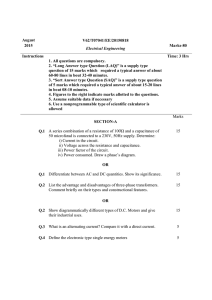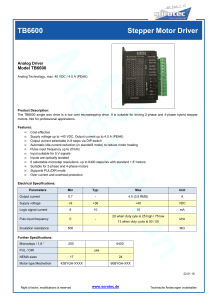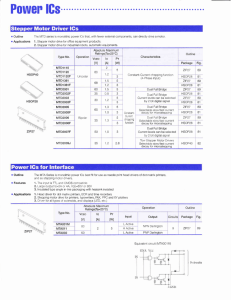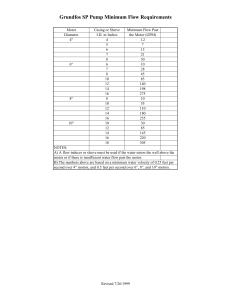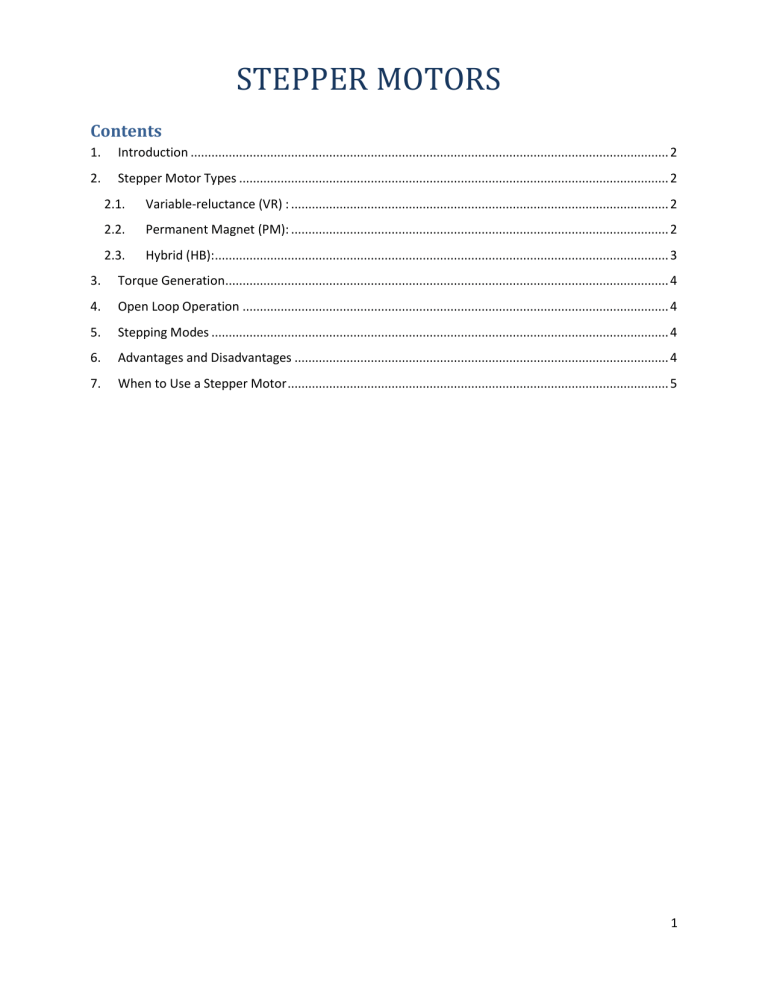
STEPPER MOTORS Contents 1. Introduction .......................................................................................................................................... 2 2. Stepper Motor Types ............................................................................................................................ 2 2.1. Variable-reluctance (VR) : ............................................................................................................. 2 2.2. Permanent Magnet (PM): ............................................................................................................. 2 2.3. Hybrid (HB):................................................................................................................................... 3 3. Torque Generation................................................................................................................................ 4 4. Open Loop Operation ........................................................................................................................... 4 5. Stepping Modes .................................................................................................................................... 4 6. Advantages and Disadvantages ............................................................................................................ 4 7. When to Use a Stepper Motor .............................................................................................................. 5 1 STEPPER MOTORS 1. Introduction A stepper motor is an electromechanicaldevice which converts electrical pulses intodiscrete mechanical movements. The shaftor spindle of a stepper motor rotates indiscrete step increments when electricalcommand pulses are applied to it in theproper sequence. The motors rotation hasseveral direct relationships to these appliedinput pulses. The sequence of the appliedpulses is directly related to the direction ofmotor shafts rotation. The speed of themotor shafts rotation is directly related tothe frequency of the input pulses and thelength of rotation is directly related to thenumber of input pulses applied. 2. Stepper Motor Types There are three basic stepper motortypes. They are : • Variable-reluctance • Permanent-magnet • Hybrid 2.1. Variable-reluctance (VR) : This type of stepper motor has beenaround for a long time. It is probablythe easiest to understand from astructural point of view. Figure.1shows a cross section of a typical VR.stepper motor. This type of motorconsists of a soft iron multi-toothedrotor and a wound stator. When thestator windings are energized Figure.1: Variable-reluctance stepper motor with DCcurrent the poles become magnetized.Rotation occurs when the rotor teethare attracted to the energized statorpoles. 2.2. Permanent Magnet (PM): Often referred to as a “tin can” or “canstock” motor the permanent magnet step motor is a low cost and low resolution type motor with typical step angles of 7.5° to 15° (48 – 24 steps/revolution). PM motors as the name implies have permanent magnets added to the motor structure as shown in Figure.2. 2 The rotor no longer has teeth as withthe VR motor. Instead the rotor ismagnetized with alternating northand south poles situated in a straightline parallel to the rotor shaft. Thesemagnetized rotor poles provide anincreased magnetic flux intensity andbecause of this the PM motor exhibitsimproved torque characteristics whencompared with the VR type. Figure.2 Permanent magnet stepper motor 2.3. Hybrid (HB): The hybrid stepper motor is moreexpensive than the PM stepper motorbut provides better performance withrespect to step resolution, torque andspeed. Typical step angles for the HB stepper motor range from 3.6° to 0.9°(100 – 400 steps per revolution). Thehybrid stepper motor combines thebest features of both the PM and VRtype stepper motors. Figure.3 shows the cut-sectional view of a hybrid stepper motor. The rotor ismulti-toothed like the VR motor andcontains an axially magnetized concentric magnet around its shaft. Theteeth on the rotor provide an evenbetter path which helps guide themagnetic flux to preferred locations in the airgap. This further increases thedetent, holding and dynamic torquecharacteristics of the motor when compared with both the VR and PMtypes. Figure.3 Hybrid stepper motor The two most commonly used typesof stepper motors are the permanentmagnet and the hybrid types. If adesigner is not sure which type willbest fit his applications requirementshe/she should first evaluate the PM type, asit is normally several times less expensive. If not then the hybrid motor maybe the right choice. 3 3. Torque Generation The torque produced by a steppermotor depends on several factors. Step rate Drive current in the windings Drive design or type In a stepper motor,torque is developed when the magnetic fluxes of therotor and stator are displaced fromeach other. The stator is made up of ahigh permeability magnetic material.The presence of this high permeabilitymaterial causes the magnetic flux tobe confined for the most part to thepaths defined by the stator structurein the same fashion that currents areconfined to the conductors of an electronic circuit. This serves to concentrate the flux at the stator poles. The torque output produced by the motoris proportional to the intensity of themagnetic flux generated when thewinding is energized.The basic relationship whichdefines the intensity of the magneticflux is defined by: 𝑯= 𝑵𝒊 𝒍 where, N = The number of winding turns i = current H = Magnetic field intensity l = Magnetic flux path length This relationship shows that themagnetic flux intensity and consequently the torque is proportional tothe number of winding turns and thecurrent and inversely proportional tothe length of the magnetic flux path.From this basic relationship one cansee that the same frame size steppermotor could have very different torqueoutput capabilities simply by changing the winding parameters. 4. Open Loop Operation One of the most significant advantages of a stepper motor is its ability to be accurately controlled in an open loop system. Open loop control means no feedback information about position is needed. This type of control eliminates the need for expensive sensing and feedback devices such as optical encoders. The position of the rotor can be known by simply keeping track of the input step pulses. 5. Stepping Modes The following are the most commondrive modes. Wave Drive (1 phase on) Full Step Drive (2 phases on) Half Step Drive (1 & 2 phases on) Microstepping (Continuouslyvarying motor currents) 6. Advantages and Disadvantages The stepper motors have a variety of advantages and a few disadvantages. These are listed below: Advantages: The rotation angle of the motor is proportional to the input pulse. The motor has full torque at standstill (if the windings are energized) 4 Precise positioning and repeatability of movement since good stepper motors have an accuracy of 3 – 5% of a step and this error is non-cumulative from one step to the next. Excellent response to starting/stopping/reversing. Very reliable since there are no contact brushes in the motor. Therefore the life of the motor is simply dependent on the life of the bearing. The motors response to digital input pulses provides open-loop control, making the motor simpler and less costly to control. It is possible to achieve very low speed synchronous rotation with a load that is directly coupled to the shaft. A wide range of rotational speeds can be realized as the speed is proportional to the frequency of the input pulses. Disadvantages: Resonances can occur if not properly controlled. Not easy to operate at extremely high speeds. 7. When to Use a Stepper Motor A stepper motor can be a good choicewhenever controlled movement isrequired. They can be used to advantage in applications where you need tocontrol rotation angle, speed, positionand synchronism. Because of the inherent advantages listed previously,stepper motors have found their place in many different applications. Someof these include printers, plotters,highend office equipment, hard diskdrives, medical equipment, faxmachines, automotive and many more. 5
